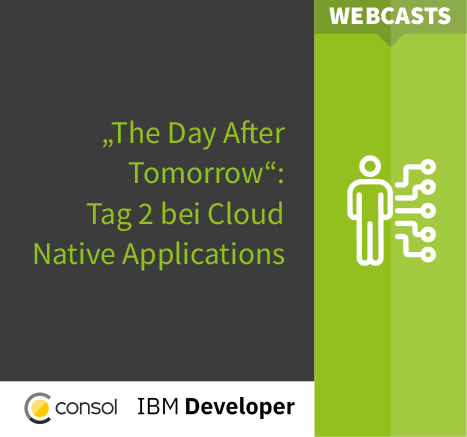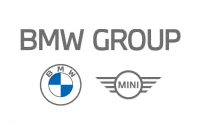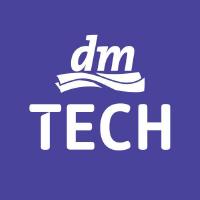Webcast ConSol + IBM: Cloud-native Applications
Wir haben unsere Applikation auf einer Cloud erfolgreich deployed. Das Going-live lief auch reibungslos. Nachdem die kritische Phase überstanden ist und sich der Staub gelegt hat, gehen wir nun in den Regelbetrieb über.
Ein langweiliger Betrieb ist ein guter Betrieb
Damit stellen sich die folgenden Fragen: Wie geht es weiter? Was muss gemacht werden, damit der Betrieb der Applikation möglichst langweilig ist - heißt also störungsfrei und ohne nennenswerte Vorkommnisse? Mit diesen offenen Punkten beschäftigen wir uns "am Tag danach".
Tag 2 - The Day After Tomorrow
In unserer Webcastreihe greifen wir einige Aspekte auf, die Voraussetzung dafür sind, dass der Regelbetrieb für alle Beteiligten stressfrei vonstatten geht. Wir fokussieren hierbei drei Kategorien, auf die wir näher eingehen:
- Automatisierung – Ziel muss es sein, beim Bauen und Ausrollen von Applikationen keine manuellen Schritte mehr durchführen zu müssen.
- Observability – Wir spüren Fehler auf, bevor sie passieren oder beheben sie, bevor sie ein Kunde bemerkt.
- Effizienz – Faster, Higer, Further: Das können wir machen, damit wir Applikationen schneller entwickeln und ausrollen können.

Die Webcast-Aufzeichnungen zum Download
„The Day After Tomorrow“: Tag 2 bei Cloud Native Applications
„GitOps with Flux and Flagger“
With the rising popularity of implementing GitOps patterns into the DevOps Lifecycle, it get's more important to secure your production deployments.
With the combination of Flux V2 for automated GitOps rollouts and flagger, we can take care of safe and reliable production deployments. Flagger enables us to do automated Blue/Green and Canary deployments and automatically roll back to the previous version, in case the quality gates will fail.
In this talk we will show the different deployment strategies that flagger offers and will show how an fully automated delivery can look like.
Speaker: Sebastian Tiggelkamp, Software Engineer at ConSol Düsseldorf
"Operator development made easy with Helm"
This talk will give you an introduction how to create a Helm based Operators with the Operator SDK. The helm chart which we are going to use will setup a namespace with all bells and whistles. We will create an Operator based on this chart and show how to define a CRD that will be used by the Operator. Furthermore, we will explore which other resources are created for the new Operator. Finally, we show an integration of this Operator with ArgoCD.
Speaker: Olaf Meyer, Senior Software Engineer at ConSol Munich
"Remote development of Quarkus applications"
A central focus of Quarkus is developer joy and productivity. As part of this focus, Quarkus provides a powerful development mode which, among other things, allows true hot compilation of code.
In this talk we will take a look at this feature in detail. Aside from allowing hot reloading locally, we can also configure our application to allow hot reloading remotely. For example, the application could be running in a docker container or on a kubernetes-/openshift-cluster. This improves Dev/Prod-parity and thus enhances the development lifecycle.
Speaker: Marco Bungart, Senior Software Engineer at ConSol Düsseldorf
"Messaging with Quarkus"
Utilizing messaging systems grants us the capability to decouple services from each other: downtime of a service consuming messages does not impact the functionality of the service sending messages and vice-versa.
In this talk we will discuss how to setup and use messaging systems. As practical examples, we use AMQP backed by ArtemisMQ, as well as kafka to send and receive messages, automatically as well as programmatically.
Speaker: Marco Bungart, Senior Software Engineer at ConSol Düsseldorf
"Using Automation Tools To Deploy And Operate Applications In Real World Scenarios"
How is automation done in real world (and) on existing systems. This webcast shows our way from existing handmade installations to ansible playbook managed environment.
Why did we choose ansible over others? A demo shows installation and how automation tools can reduce stress during incident remediation situations.
Speaker: Christian Hilgers, Senior Software Engineer at ConSol Düsseldorf
"Kubernetes as Driver of Generic IT Automation"
Kubernetes as a platform is moving fast from being the "new IT" to standing right in the center of most companies infrastructure. What does that mean for IT Automation? For its own purposes, Kubernetes already comes with a well-engineered declarative model of managing computing resources that has proven to be very efficient. In classic IT, likewise proven automation solutions like Red Hat Ansible are established. This forms two automation silos, and as we all know: Silos are a bad thing. Is there a way to bridge this gap?
In this session we will highlight the possibilities to use Kubernetes state management as backbone for IT automation by extending it with custom operators using Red Hat Ansible. Ansible with its focus on idempotency is a really great match for implementing Kubernetes-Operators and doing it to automate non-K8s resources, just like you would do with Ansible Tower, is easier than you might think. We will have a look at different use cases and provide a strategic outlook.
Speaker: Oliver Weise, Team Lead Software and DevOps engineering at ConSol Düsseldorf









 Openshift-Beratung
Openshift-Beratung
 Open Source Monitoring
Open Source Monitoring
 Integration-Testing
Integration-Testing






